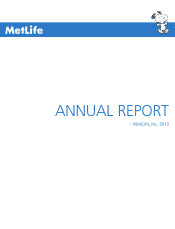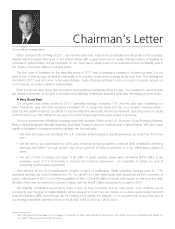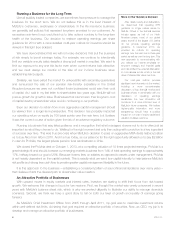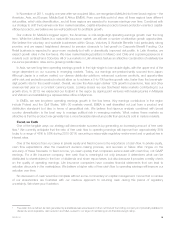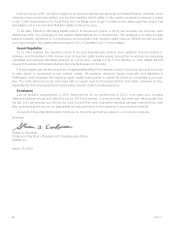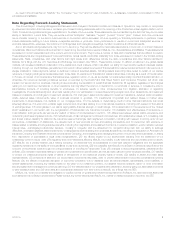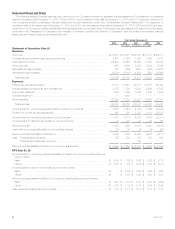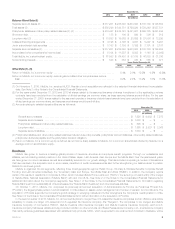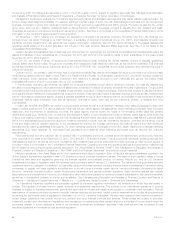MetLife 2013 Annual Report Download - page 4
Download and view the complete annual report
Please find page 4 of the 2013 MetLife annual report below. You can navigate through the pages in the report by either clicking on the pages listed below, or by using the keyword search tool below to find specific information within the annual report.
Running a Business for the Long Term
Like all publicly traded companies, we sometimes face pressure to manage the
business for the short term. We do not believe this is in the best interest of
MetLife’s customers, employees or shareholders. In the life insurance business,
we generally sell policies that represent long-term promises to our customers. An
excessive near-term focus could lead us to take actions contrary to the long-term
health of the business. Our decision to replace operating earnings per share
guidance for 2014 with a more detailed multi-year outlook for investors should be
viewed in this light (see sidebar).
We have demonstrated that we will not make decisions that put the business
at risk simply to boost earnings today. For example, we continue to intentionally
limit our variable annuity sales despite a strong bull market in equities. We want to
limit our exposure to any one risk factor even when current returns look attractive,
and we must always be mindful of the size of our in-force business when
establishing risk budgets.
Similarly, we have exited the market for universal life with secondary guarantees
and announced the sale of our pension risk-transfer subsidiary in the United
Kingdom because we were not confident these businesses could earn their cost
of capital. As I said in my first letter to shareholders two years ago, MetLife will not
pursue growth for growth’s sake. Businesses that cannot earn their long-term cost
of capital destroy shareholder value and do not belong in our portfolio.
Even our decision to refrain from more aggressive capital management should
be viewed from a longer-term perspective. This decision has probably impacted
our operating return on equity by 100 basis points over the near term, but I believe
it was the correct course of action given the risk of an adverse regulatory outcome.
More on Our Guidance Decision
After careful study and deliberation,
we determined that operating EPS
guidance no longer makes sense for
MetLife. Others in the financial services
industry agree, as half of our North
American peers, most of our global
peers, and all of the largest U.S. banks
do not provide operating earnings
guidance. In December 2013, we
provided an outlook for operating
earnings over the next one-to-three-year
period as well as over the long term. This
new approach to communicating with
you reflects our internal emphasis on
long-term strategic and financial goals
and has shifted the external discussion
to our business model, which is the real
driver of shareholder value over time.
Our multi-year outlook provides
significant new information to the market,
including a more comprehensive
discussion of key financial metrics and
business drivers. In combination with our
discussion of operating earnings
sensitivities, the new information will
contribute to a more informed view of
MetLife’s future prospects. We believe
higher-quality information and more
transparency should have a positive
impact on our cost of equity capital and
valuation multiples over time.
Running a business this way takes patience and a recognition that what managers choose not to do is often just as
important as what they choose to do. Waiting for the right moment and only then acting with conviction is a key ingredient
of success over time. This was true pre-crisis when MetLife’s decision to pass on aggressive M&A deals helped position
us to buy Alico from AIG in 2010. And it is true today, as our patience for the right opportunity allowed us to pay $2 billion
in cash for ProVida, the largest private pension fund administrator in Chile.
We closed the ProVida deal on October 1, 2013, at a compelling valuation of 10 times projected earnings. ProVida is a
great strategic fit and should increase our emerging markets business from 14% of total operating earnings to approximately
17%, halfway toward our goal of 20%. Because it earns fees on salaries as opposed to assets under management, ProVida
is not heavily dependent on the capital markets. This is exactly what we want: low capital intensity to help balance MetLife’s
risk profile and strong free cash flow to provide greater capital management flexibility in the future.
It is this approach to the business – establishing a consistent pattern of sound financial decisions over many years –
that I believe charts the clearest path to shareholder value creation.
An Attractive Portfolio of Businesses
With upward moves in equity markets and interest rates, investors are starting to shift their focus from risk toward
growth. We welcome this change in focus for two reasons. First, we thought the market was overly concerned in recent
years with MetLife’s balance sheet risk, which is why we worked diligently to illustrate our ability to manage downside
scenarios. Second, we think we have a good story to tell on both our level of growth and quality of earnings going
forward.
As MetLife’s Chief Investment Officer from 2005 through April 2011, my goal was to maximize investment returns
within well-defined risk limits. Achieving that goal required an attractive portfolio of securities. Now, as CEO, my job is to
develop and manage an attractive portfolio of businesses.
ii MetLife, Inc.

